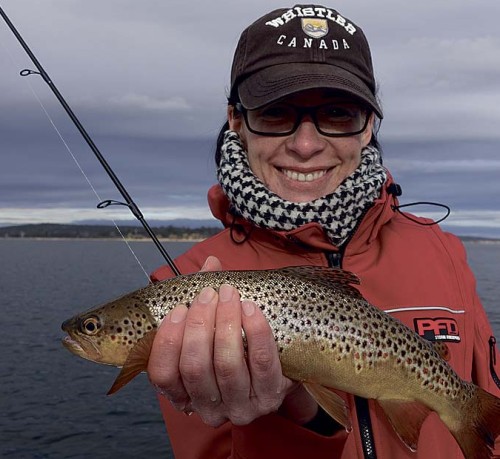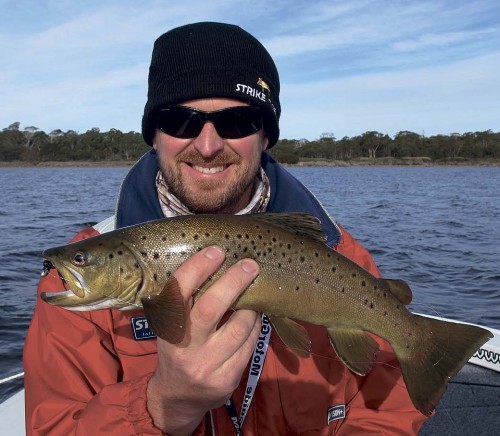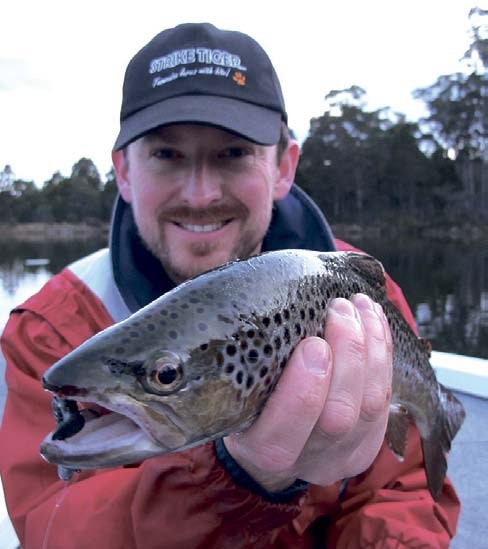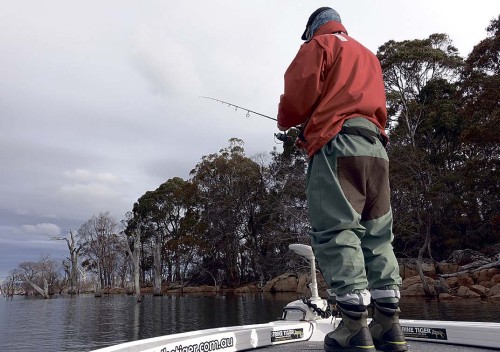 Presented from Issue 115, April 2015
Presented from Issue 115, April 2015
While the action on the saltwater has been okay, the Tasmanian trout season has been far from great. Over the summer, I have fished many of the highland lakes, using both dry fly and micro-sized plastics. Although some of my trips have been productive, there have been many trips where I have put in long hours and plenty of effort, for only a few fish. It is with particular sadness, that Arthurs Lake - my favourite place to fish, has also let me down on a number of occasions. As with any fishing trip, I always endeavour to find a ‘silver lining’, and for me it has been that the few fish I have caught were noticeably larger, and in better condition, than the ones I caught the previous year.
 |
| It might be the end of the season, but the trout are still there |
Although the end of the trout season is fast approaching, I am sure that there are many anglers keen to make the most of the time remaining. The weather is cooling down right across the state, and we have already seen some highland snowfalls. With trout feeding heavily before spawning over the next couple of months, April has the potential to be a month filled with some better trout fishing action.
As the cold weather sets in and the water temperature drops, surface insect activity naturally declines. Trout will instinctively turn their attention to sub-surface food sources. As many of you know, in many of the highland lakes, galaxias are a red-hot item on the trout menu! It is also no secret that if you can imitate this food source you can often fool the hungry trout into taking your offering. Hard body lures and wet flies are two options that will work well. But for me, this is a great time of the year to target trout using soft plastics. Here are some tips to help you to increase your end- of-season catch rate!
Soft plastic colours
I find that darker colours tend to work well late in the season. As most of you know, ‘black n gold’ is an ever-popular choice, for both early and late season, with black creating a highly visible silhouette under almost any conditions. It is also probably the most effective colour day or night. With the addition of ‘gold fleck’ or ‘gold glitter’, this colour has the ability to reflect some light, which, much like a gold metal spinner or spoon, attracts attention.
Natural colour combinations, similar to juvenile trout or galaxias, will also work very well. Look for plastics with natural looking shades of brown or olive. Ensuring that they are blended with some gold, silver or copper coloured fleck will make them all the more attractive to trout.
Combinations of black and red, or even black and orange are also great late season soft plastic colours. The black stands out, while the highlighted colour (red or orange) will work to trigger strikes from even the fussiest of fish. You will find that these colours are particularly appealing to trout around spawning time.
If you don’t have these colours in your soft plastic arsenal, then you can easily modify your lures by adding a splash of red or orange paint. Grab some bright red or orange nail polish and start painting some highlights on those plastics. Painting the belly of the plastic in a bright colour is a great start!
 |
| Plastics work well |
What type of soft plastic?
In my opinion, you can’t go past a ‘t-tail’ or ‘paddle tail’ soft plastic when fishing for trout. This style of soft plastic lure has plenty of in-built tail action and is a good galaxias representation. Some brands have more action than others, but it is the tight vibration that is really appealing to trout. In some instances, this tail action will provoke what’s known as a ‘reaction bite’. This is where a trout will simply want to attack your lure in order to protect its territory. This is an especially common behaviour in the time leading up to spawning.
Plastics such as the Black and Gold Berkley 2.5” t-tail, the Homebrew Strike Tiger 2.5” t-tail, the Garry Glitter Squidgee or the YEP Black and Gold flapper, all possess the desirable qualities mentioned, and are all great end of season choices for Tasmania. An important consideration when selecting soft plastic lures is to avoid those made of plastic compounds that are too stiff. If the plastic is too stiff, the lure will generally not have very much tail action. Choose something that will work well under the slowest of retrieves and your success rate should improve.
The ‘stiffness’ of the lure is not so much a concern for ‘stick baits’ or soft-plastic ‘minnows’ because the swim action relies solely on the input from the angler. While these lures have little to no built-in action, they are probably an even better galaxias representation. Like t-tails, stick baits also work exceptionally well late in the season.
If you intend to use stick baits or soft plastic ‘minnows’, you need to remember that they rely on ‘angler input’ to get the lure performing at its ‘enticing’ best. When fishing these plastics, the aim is to make them look as life-like as possible. Generally speaking, ‘stick-baiting’ is a more advanced fishing technique, but, as with all things new, it will get easier if you put in the time and practice.
Modify the appearance of your jigheads
If you want to go one step better in terms of presentation, I would suggest ‘pimping’ or ‘modifying’ the jighead on which your plastic is rigged. One simple method is to paint the jighead to match the colour of the lure. Coloured nail polish is a suitable product for this task. You also may want to add some realistic looking red (or natural coloured) lure eyes. Adhesive lure eyes are readily available from stores or online. Eyes that are 3mm in diameter are generally suitable for most jighead applications.
Once you have stuck the eyes on the jighead, you should coat them with a layer of clear nail polish. This will result in a professional finish to your jighead, but more importantly, the eyes will be less likely to come off. You may think that it is a fiddly process – but so is fly tying! Adding that little extra detail will enhance the appearance of your lure, therefore making it more appealing to trout. For most trout applications, I usually rig a soft plastic on anything ranging from a 1/16 through to a 1/12 weight jig head (hook gape sized 1/0 or 2). I use a loop knot to finish the connection to the jig head. This ensures that the lure can move freely and that its presentation is as natural as possible.
Target wind-blown shores
Fishing wind-blown shorelines with plastics is a proven trout catching method for late in the season. Hard body lures also work very well with this method. The constant pounding of the waves against the shore works to stir up the natural bait – a bonus for us anglers! Galaxias, one of the items on a trout’s menu, are little fish that spawn on the rocky shorelines of many Tasmanian lakes. If conditions are fierce enough, the waves crashing against the shoreline can actually kill many of them. Of the ones that survive, some will be temporarily ‘stunned’, resulting in erratic and impaired swimming actions. Trout will patrol such shorelines, chasing the live galaxias. They will also happily take the opportunity to get an easy meal, mopping up any dead galaxias that have been slammed against the rocks by the waves.
Target structure
Structure provides trout with safe hiding places. Think of those dead trees sticking out of the water in a lot of our lakes. They are all potential trout holding areas that should never be overlooked. When targeting timber structures, accurate casts right up against the timber are important. Let the plastic flutter down hard against the target and don’t forget to anticipate any strikes as it sinks. Time and effort at these locations is usually well rewarded.
Structure is not just limited to timber. Weed beds are another great area to target. They normally hold good amounts of ‘trout tucker’, as well as providing the trout with cover and concealment. As the saying goes, ‘where there is food, there is fish’, and this is certainly true for weed beds. Although, great fishing spots, they are located sub-surface and can take some finding if your boat does not have a sounder.
 |
| The days may be cold, but rug up and keep fishing. |
Some good soft plastic retrieves
‘The Lift & Drop’
I use a variety of soft plastic retrieves, but usually start off with the simple ‘lift and drop’. This one works very well for mid to deep sections of water, because the plastic is able to travel a considerable distance as it swims to the surface and then naturally flutters to the bottom. The technique is exactly as it sounds. Cast your plastic, let it sink, then lift and drop. Wind slowly as you drop to take up the slack line, and then repeat. It is as simple as that! If you get no interest using this technique, then incorporate some fast and slow twitches into the lift part of the retrieve. The key here is to only move your rod tip an inch or two either way. If you move it any further, your soft plastic may not swim naturally.
‘The Slow Roll’
Slow rolling a soft plastic is another easy retrieve that works in lakes, rivers and even small creeks. This technique requires the angler to slowly (and constantly) retrieve a plastic along the bottom. With an inbuilt tail action, curl tail grubs and t-tail/paddle-tail soft plastics are perfect choices for this particular method. Start out by casting your plastic and let it sink to the bottom. You will know that your plastic is on the bottom by watching your line – as soon as it goes slack, you are there. Next, lift your rod tip slightly. It is now just a matter of winding your lure back ever so slowly. You should feel your plastic touch the bottom every now and then. If the action is slow – try throwing in a few pauses. Extend the time that you pause your plastic for in order to give the trout some extra time to observe your offering.
‘The Rip and Pause’
This method is well suited to fishing those wind- blown shorelines. If you are fishing these areas, you will likely be fishing shallow. So, as soon as your plastic hits the water, wind as fast as you can for 2 or 3 sharp turns of your reel. Be sure to hold your rod-tip high, as this will ensure that your plastic will swim shallow right from the start. If you are fishing deeper water, just remember to let the plastic sink a bit first. You will also need to hold your rod tip lower.
The next step is to pause. This allows the plastic to sink for a second or so. Repeat the rip, and then pause again. As you progress the plastic into deeper water, hold the rod tip lower to allow it to dive deeper. You will also need to increase the number of times you turn the reel when you ‘rip’ the lure, as well as extending the pause time as you continue the retrieve.
I find that when using this method, I can trigger interest, and ultimately a reaction-bite, from trout that have ‘shut down’. You may also find that many strikes will be on the pause part of this particular retrieve. Anticipating this is therefore very important for successful hook-ups.
Conclusion
The soft plastic techniques that I have described in this story are excellent options for fishing our highland lakes late in the season. However, they will work on trout just about anywhere, and can be used by anglers of all skill levels. They will work if you are fishing on foot, from the shore, or fishing from a boat or kayak. If you are heading out for a fish before the season ends, keep in mind the target areas and techniques that I have described. Don’t be afraid to experiment with the presentation of your lures. Remember, something that is just a little bit different could be the thing that turns your ‘fishing’ trip into a ‘fish catching’ trip! Good luck!
Mic Rybka




